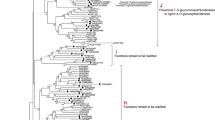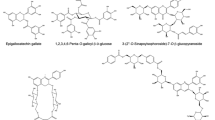Abstract
Arabidopsis thaliana Heynh. harbors UDP-glucose-dependent glucosyltransferase (UGT; EC 2.4.1.-) activities that are able to glucosylate xenobiotic substrates as a crucial step in their detoxification, similar to other plants. However, it has remained elusive whether side-activities of UGTs acting on endogenous substrates could account for that property. Therefore, seven recombinantly expressed A. thaliana enzymes were tested using the phytotoxic xenobiotic model compound 2,4,5-trichlorophenol (TCP) as a substrate. The enzymes were selected from the large Arabidopsis UGT gene family because their previously identified putative endogenous substrates comprised both carboxylic acid, and phenolic and aliphatic hydroxyl moieties as biochemical targets. In addition, UGT75D1, which was shown to accept the endogenous flavonoid kaempferol as a substrate, was included. All enzymes tested, except the sterol-conjugating UGT80A2, glucosylated TCP as a parallel activity. The K m values for TCP ranged from 0.059 to 1.25 mM. When tested at saturating concentrations of the native substrates the glucosylation of TCP by the glucose-ester-forming UGT84A1 and UGT84A2 was suppressed by p-coumaric acid and sinapic acid, respectively. In contrast, the activities of UGT72E2 and UGT75D1 toward their phenolic native substrates and the xenobiotic TCP were mutually inhibited. TCP was a competitive inhibitor of sinapyl alcohol glucosylation by UGT72E2. These overlapping in vitro activities suggest cross-talk between the detoxification of xenobiotics and endogenous metabolism at the biochemical level, depending on the presence of competing substrates and enzymes.




Similar content being viewed by others
Abbreviations
- GST:
-
glutathione-S-transferase
- TCP:
-
2,4,5-trichlorophenol
- UDPG:
-
UDP-glucose
- UGT:
-
UDP-glucose-dependent glucosyltransferase
References
Brazier M, Cole DJ, Edwards R (2002) O-glucosyltransferase activities toward phenolic natural products and xenobiotics in wheat and herbicide-resistant and herbicide-susceptible black-grass (Alopecurus myosuroides). Phytochemistry 59:149–156
Chang S, Puryear J, Cairney J (1993) A simple and efficient method for isolating RNA from pine trees. Plant Mol Biol Rep 11:113–116
Cole DJ, Edwards R (2000) Secondary metabolism of agrochemicals in plants. In: Roberts T (ed) Metabolism of agrochemicals in plants. Wiley, New York, pp 107–154
Cornish-Bowden A (1974) A simple graphical method for determining the inhibition constants of mixed, uncompetitive and non-competitive inhibitors. Biochem J 137:143–144
Dixon M (1953) The determination of enzyme inhibitor constants. Biochem J 55:170–171
Ford CM, Boss PK, Hoj BP (1998) Cloning and characterization of Vitis vinifera UDP-glucose:flavonoid 3-O-glucosyltansferase, a homologue of the enzyme encoded by the maize Bronze-1 locus that may primarily serve to glucosylate anthocyanidins in vivo. J Biol Chem 273:9224–9233
Fraissinet-Tachet L, Baltz R, Chong J, Kauffmann S, Fritig B, Saindrenan P (1998) Two tobacco genes induced by infection, elicitor and salicylic acid encode glucosyltransferases acting on phenylpropanoids and benzoic acid derivatives, including salicylic acid. FEBS Lett 437:319–323
Gallandt ER, Balke NE (1995) Xenobiotic glucosyltransferase activity from suspension-cultured Glycine max cell. Pestic Sci 43:31–40
Gibeaut DM, Hulett J, Cramer GR, Seemann JR (1997) Maximal biomass of Arabidopsis thaliana using a simple, low-maintenance hydroponic method and favorable environmental conditions. Plant Physiol 115:317–319
Harvey PJ, Campanella BF, Castro PML, Harms H, Lichtfouse E, Schäffner AR, Smrcek S, Werck-Reichhart D (2002) Phytoremediation of polyaromatic hydrocarbons, anilines and phenols. Environ Sci Pollut Res 9:29–47
Jackson RG, Lim E, Li Y, Kowalczyk M, Sandberg G, Hoggett J, Ashford DA, Bowles DJ (2001) Identification and biochemical characterization of an Arabidopsis indole-3-acetic acid glucosyltransferase. J Biol Chem 276:4350–4356
Jones P, Vogt T (2001) Glycosyltransferases in secondary plant metabolism: tranquilizers and stimulant controllers. Planta 213:164–174
Jones PR, Moller BL, Hoj PB (1999) The UDP-glucose:p-hydroxymandelonitrile-O-glucosyltransferase that catalyzes the last step in synthesis of the cyanogenic glucoside dhurrin in Sorghum bicolor. J Biol Chem 274:35483–35491
King CD, Green MD, Rios GR, Coffman BL, Owens IS, Bishop WP, Tephly TR (1996) The glucuronidation of exogenous and endogenous compounds by stably expressed rat and human UDP-glucuronosyltransferase 1.1. Arch Biochem Biophys 332:92–100
Kita M, Hirata Y, Moriguchi T, Endo-Inagaki T, Matsumoto R, Hasegawa S, Suhayda CG, Omura M (2000) Molecular cloning and characterization of a novel gene encoding limonoid UDP-glucosyltransferase in Citrus. FEBS Lett 469:173–178
Kreuz K, Tommasini R, Martinoia E (1996) Old enzymes for a new job. Plant Physiol 111:349–353
Laemmli UK (1970) Cleavage of structural proteins during the assembly of the head pf bacteriophage T4. Nature 227:680–685
Leah JM, Worrall TL, Cobb AH (1992) Isolation and characterization of two glucosyltransferases from Glycine max associated with bentazone metabolism. Pestic Sci 34:81–87
Lee H-I, Raskin I (1999) Purification, cloning, and expression of a pathogen inducible UDP-glucose:salicylic acid glucosyltransferase from tobacco. J Biol Chem 274:36637–36642
Li Y, Baldauf S, Lim E, Bowles DJ (2001) Phylogenetic analysis of the UDP-glycosyltransferase multigene family of Arabidopsis thaliana. J Biol Chem 276:4338–4343
Lim E, Li Y, Parr A, Jackson R, Ashford DA, Bowles DJ (2001) Identification of glucosyltransferase genes involved in sinapate metabolism and lignin synthesis in Arabidopsis. J Biol Chem 276:4344–4349
Lim E, Doucet CJ, Li Y, Elias L, Worrall D, Spencer SP, Ross J, Bowles DJ (2002) The activity of Arabidopsis glycosyltransferases toward salicylic acid, 4-hydroxybenzoic acid, and other benzoates. J Biol Chem 277:586–592
Martin RC, Mok MC, Mok DWS (1999) Isolation of a cytokinin gene, ZOG1, encoding zeatin O-glucosyltransferase from Phaseolus lunatus. Proc Natl Acad Sci USA 96:284–289
Milkowski C, Baumert A, Strack D (2000) Identification of four Arabidopsis genes encoding hydroxycinnamate glucosyltransferases. FEBS Lett 486:183–184
Moehs CP, Allen PV, Friedman M, Belknap WR (1997) Cloning and expression of solanidine UDP-glucose glucosyltransferase from potato. Plant J 11:227–236
Pflugmacher S, Sandermann H (1998) Taxonomic distribution of plant glucosyltransferases acting on xenobiotics. Phytochemistry 49:507–511
Pichersky E, Gang DR (2000) Genetics and biochemistry of secondary metabolites in plants: an evolutionary perspective. Trends Plant Sci 5:439–445
Ross J, Li Y, Lim E, Bowles DJ (2001) Protein family review. Higher plant glycosyltransferases. Genome Biol 2:3004.13004.6
Sandermann H (1994) Higher plant metabolism of xenobiotics: the "green liver" concept. Pharmacogenetics 4:225–241
Sandermann H, Schmitt R, Eckey H, Bauknecht T (1991) Plant biochemistry of xenobiotics: isolation and properties of soybean O- and N-glucosyl and O- and N-malonyltransferases for chlorinated phenols and anilines. Arch Biochem Biophys 287:341–350
Schmidt B, Rivero C, Thiede B (1995) 3,4-Dichloroaniline N-glucosyl- and N-malonyltransferase activities in cell cultures and plants of soybean and wheat. Phytochemistry 39:81–84
Taguchi G, Yatawa T, Hayashida N, Okazaki M (2001) Molecular cloning and heterologous expression of novel glucosyltransferases from tobacco cultured cells that have broad substrate specificity and are induced by salicylic acid and auxin. Eur J Biochem 268:4086–4094
Vogt T (2002) Substrate specificity and sequence analysis define a polyphyletic origin of betanidin 5- and 6-O-glucosyltransferase from Dorotheanthus bellidiformis. Planta 214:492–495
Vogt T, Jones P (2000) Glycosyltransferases in plant natural product synthesis: characterization of a supergene family. Trends Plant Sci 5:380–386
Vogt T, Grimm R, Strack D (1999) Cloning and expression of a cDNA encoding betanidin 5-O-glucosyltransferase, a betanidin- and flavonoid-specific enzyme with high homology to inducible glucosyltransferases from Solanaceae. Plant J 19:509–519
von Rad U, Hüttl R, Lottspeich F, Gierl A, Frey M (2001) Two glucosyltransferases are involved in detoxification of benzoxazinoids in maize. Plant J 28:633–642
Warnecke DC, Baltrusch M, Buck F, Wolter FP, Heinz E (1997) UDP-glucose:sterol glucosyltransferase: cloning and functional expression in Escherichia coli. Plant Mol Biol 35:597–603
Weig A, Deswarte C, Chrispeels MJ (1997) The major intrinsic protein family of Arabidopsis has 23 members that form three distinct groups with functional aquaporins in each group. Plant Physiol 114:1347–1357
Wetzel A, Sandermann H (1994) Plant biochemistry of xenobiotics: isolation and characterization of a soybean O-glucosyltransferase of DDT metabolism. Arch Biochem Biophys 314:323–328
Yamazaki M, Gong Z, Fukuchi-Mizutani M, Fukui Y, Tanaka Y, Kusumi T, Saito K (1999) Molecular cloning and biochemical characterization of a novel anthocyanin 5-O-glucosyltransferase by mRNA differential display for plant forms regarding anthocyanin. J Biol Chem 274:7405–7411
Acknowledgements
The authors thank Birgit Geist, Elke Gerstner, Elisabeth Schindler, and Susanna Holzinger for technical assistance. Matthias Affenzeller from our laboratory provided RNA from different A. thaliana tissues. We are indebted to Drs. Werner Heller, Christian Langebartels, Dieter Ernst and Heinrich Sandermann (all our Institute) for critical reading of the manuscript. Two anonymous referees provided valuable comments.
Author information
Authors and Affiliations
Corresponding author
Rights and permissions
About this article
Cite this article
Meßner, B., Thulke, O. & Schäffner, A.R. Arabidopsis glucosyltransferases with activities toward both endogenous and xenobiotic substrates. Planta 217, 138–146 (2003). https://doi.org/10.1007/s00425-002-0969-0
Received:
Accepted:
Published:
Issue Date:
DOI: https://doi.org/10.1007/s00425-002-0969-0




